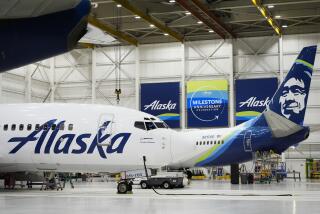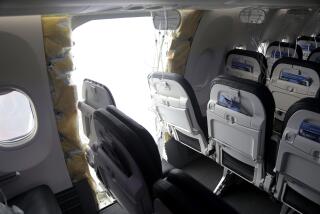NTSB traces Boeing 787 Dreamliner fire to battery cell, but questions remain
A month into investigating a fire that broke out on Boeing Co.’s grounded 787 Dreamliner passenger jets, the National Transportation Safety Board said it found a short-circuit in one of the aircraft’s lithium ion batteries and even traced it to a specific cell, but still doesn’t have a cause.
Speaking to reporters Thursday from Washington, NTSB Chairwoman Deborah Hersman said the agency hasn’t reached a conclusion on the cause of the fire that occurred in Boston on Jan. 7. But investigators have been “working around the clock to learn about what happened and why.”
The lithium-ion battery system on the 787 is a cluster of eight individual cells packaged together in one box. Hersman said that all mechanical damage to the cells and the battery case occurred after the short-circuiting in Cell No. 6.
FULL COVERAGE: Boeing’s troubled Dreamliner
The battery then experienced “thermal runaway,” a chain reaction in which heat spreads rapidly from cell to cell. The heat cascaded to other cells in the battery, as is evidenced by the damage to those adjacent cells, Hersman said.
Potential causes of the initiating short-circuit that are currently being evaluated include battery charging, the design and construction of the battery, and the possibility of defects introduced during the manufacturing process, she said.
Boeing’s lithium ion batteries are made by Kyoto-based GS Yuasa Corp.
“Because of the unexpected nature of the battery failure, our investigators began reviewing the certification of the 787 battery design,” she said. “The investigation has demonstrated that a short-circuit -- in a single cell -- can propagate to adjacent cells and result in smoke and fire.”
The sweeping review for an in-service jetliner is uncommon. Boeing has delivered 50 787s to eight airlines worldwide. Six are owned by United Airlines -- the only U.S. carrier that has 787s in its fleet.
The NTSB disclosed that during the risk assessment period of the certification process, Boeing determined that the likelihood of a smoke emission event from a 787 battery would occur less than once in every 10 million flight hours.
There have been two critical battery events on the 787 fleet with fewer than 100,000 flight hours, Hersman said.
“The decision to return the fleet to flight will be made by the FAA, which underscores the importance of cooperation and coordination between our agencies,” she said.
The announcement comes after the Federal Aviation Administration grounded the 787s on Jan. 16 after an emergency landing by All Nippon Airways due to a second apparent fire involving lithium ion batteries.
The NTSB is also working with officials from Japan, Boeing, the FAA, the Navy and investigators in France.
Boeing has said it is working with its airline customers and the regulatory agencies to get the matter resolved, but it is a public relations nightmare for the Chicago company, which has long heralded the Dreamliner as a representation of 21st century air travel.
The 787, a twin-aisle aircraft that can seat 210 to 290 passengers, is the first large commercial jet with more than half its structure made of composite materials (carbon fibers meshed together with epoxy) rather than aluminum sheets. It’s also the first large commercial aircraft to involve pervasive use of electrically powered systems involving lithium-ion batteries.
Problems are expected with any new plane, especially one as complicated and sophisticated as the 787, experts have said. But problems with new technology such as the lithium ion batteries may hold tougher challenges for Boeing.
The company has taken 848 orders for the 787 from airlines and aircraft leasing firms around the world. Depending on the version ordered, the price ranges from $206.8 million to $243.6 million per jet.
The FAA allowed a one-time, special 787 flight Thursday from Fort Worth, Texas, to the Boeing plant in Everett, Wash. The plane was in Fort Worth for a paint job, the company said.
ALSO:
Boeing asks FAA for OK to begin 787 Dreamliner test flights
Boeing defends using lithium-ion batteries in 787 Dreamliner jet
Airline says Boeing 787 grounding will affect 100,000 passengers
More to Read
Start your day right
Sign up for Essential California for news, features and recommendations from the L.A. Times and beyond in your inbox six days a week.
You may occasionally receive promotional content from the Los Angeles Times.







